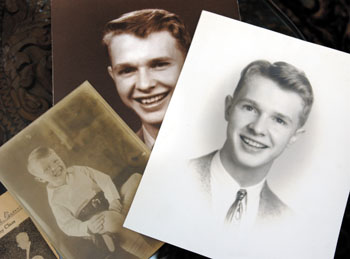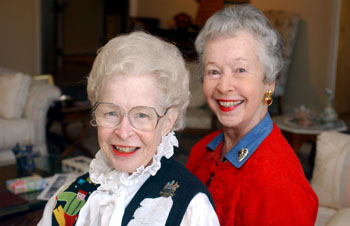
“A great football player and an even greater lady killer,” Bill Wilkerson would have lived up to his identity. (photo by Dana Johnson)
Who was Bill Wilkerson? — The man would match the identity

Nancy Fawn Wilkerson Diehl and Jane Wilkerson Yount remember “a wonderful brother” who enjoyed pulling pranks. (photo by Dana Johnson)
Should it come as a surprise that few people who make use of the Bill Wilkerson Center don’t know who Bill Wilkerson was? If they do know, the specific facts about how his name was associated with hearing and speech sciences have most likely yielded to time and supposition.
The Bill Wilkerson identity—the world-renowned center for hearing and speech sciences—has been around 51 years, more than two and a half times longer than its namesake, the son of Dr. Wesley Wilkerson, who died in 1945 at age 19.
By all accounts, though, the institution that is the Bill Wilkerson Center resembles the man who was Bill Wilkerson—popular, strong, tall and proud, yet humble and dedicated, intellectually curious and introspective yet outgoing, like George Bailey without the building and loan—or, contrary to local lore, a bad ear.
“He was a wonderful brother,” says one of his two sisters, Jane Wilkerson Yount, six years Bill’s junior. Jane and Nancy Fawn Wilkerson Diehl, who was four and a half years younger than Bill, remember their brother as doting at times, taking them on dates with him to the movies at Melrose, and prankish at others.
Bill was a shy boy, Nancy Fawn and Jane say. But his parents urged him to break out of his shell and join the speech and debate team of Hillsboro High’s Forensic League chapter. The trick worked. “He was great. He started winning awards and became so popular,” Jane says.
A high school newspaper story calls him “a great football player, and an even greater lady killer.”
Young Bill said he would become a doctor, but his sisters say that was to please their father. “He loved history and archeology,” Jane says, and they could envision him, not unlike George Bailey, traveling the globe in search of discovery.
Bill knew the location of Civil War trench lines around Nashville, and where Native American tribes lived and traveled. Many days found him horseback, riding through Lealand Hills, south of Nashville, collecting musket balls, mini cannon balls and arrowheads. He often took Jane with him. “Our mother would let us go, and we’d be gone all day,” she says.
For Christmas when Bill was 16, his parents gave him a folding shovel, one he could carry on his horse to dig for relics. His father used that shovel when ground was broken on the current building, in May 1956. Fifty years later, in December, Jane and Nancy Fawn dug that same spade into a pile of sand to commemorate the new building, now under construction.
In the movie, George Bailey was stuck at home as a 4-F during the war (because of his bad ear), an annoyance that proved to be his blessing in disguise. Bill Wilkerson got to follow the romantic notion of going into battle, and like so many other young men of his generation, it was his doom.
In 1943, when he was 17, Bill volunteered for the Civil Air Patrol. He graduated from Hillsboro High, then took a few classes at Vanderbilt. His sisters were at summer camp in Wisconsin when Bill decided to enroll in the Army. He returned home in August after training; it would be the last time. Rachael Farris, a young neighbor of the Wilkersons, was serving the Red Cross in England. She was with Bill the last time he called home, Christmas of 1944. One day in January, the telegram arrived.
“It said Bill was missing in action, and presumed dead,” Jane says. The Army, she says, couldn’t specify what day Bill became missing, or exactly which of the French or Belgian cities he was missing from. The family would later learn that Bill had volunteered to be a forward observer in the largest ground battle of World War II, the Battle of the Bulge, in which half a million American and 55,000 British troops halted Hitler’s last attempt to turn the war’s tide in his favor. Bill was one of more then 19,000 young American men to die between Dec. 16, 1944 and Jan. 28, 1945.
The news of Bill’s death still stings. “There never was a sweeter boy,” Jane says. “They should never have put a rifle in his hands and sent him off to kill someone.”
As clear as Nancy Fawn and Jane remember Bill, parts of his life — what he was like as a young boy, what he talked about that summer they were away when Bill decided to join the Army—were incomplete pictures they were unable to understand; their parents were so wrought with grief they couldn’t discuss their son.
“Mother and Daddy would not speak of Bill after he died. It was devastating to them,” says Nancy Fawn.
When finally the center for hearing and speech sciences that Wesley Wilkerson had lobbied and pushed for since the 1930s came into fruition, the board asked Dr. Wilkerson to excuse them on a certain matter of business. With him out of the room, they voted unanimously to name the center after Bill.
The sisters say their unassuming father would be pleased with the Center’s present-day prominence, and its dedication to excellence. And, they say, its new home under way brings back more memories of Bill. The family was active members of Hillsboro Presbyterian Church. After church, the girls would watch their brother go off with friends down the street for cherry Cokes at a drug store, near the site of the new building now under construction.













